Most of a person's teeth erupt in childhood. But there is an exception to this rule - wisdom teeth. They appear later than all the others. It is believed that this is why they were given such a name.
So what is the difference between “wise” teeth and all the others? At what age do they appear? How long do they grow? And can they not cut at all?
What you need to know about wisdom teeth.
How many should there be?
The normal number of wisdom teeth or "eights" in a person is 4. These are the extreme molars on the lower and upper jaws, erupting much later than all other teeth.
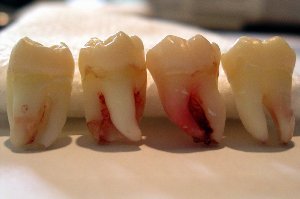 But it is impossible to speak unambiguously about their number, since over time the human jawbone underwent evolution and decreased in size. The result was a reduction in the number of teeth located on it.
But it is impossible to speak unambiguously about their number, since over time the human jawbone underwent evolution and decreased in size. The result was a reduction in the number of teeth located on it.
Therefore, someone grows all 4 "eights", someone has two, and for some, these chewing elements may not appear at all.
Most often, wisdom teeth erupt in pairs. But there are cases when a person has only one or three last molars in a row.
Features of location and eruption
- These are the outermost teeth on both sides of the lower and upper jaws. Like other paired teeth, they are located symmetrically relative to each other and are the eighth in a row, starting from the middle incisor. Hence them dental name- eights.
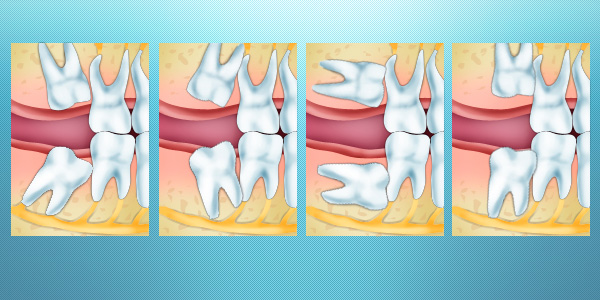 Unfortunately, the peculiarity of these teeth is that they rarely occupy the correct position on the jawbone. Often, these molars develop and erupt with some kind of anomaly. This can be expressed in their incorrect location or direction of growth, which brings a lot of trouble to a person.
Unfortunately, the peculiarity of these teeth is that they rarely occupy the correct position on the jawbone. Often, these molars develop and erupt with some kind of anomaly. This can be expressed in their incorrect location or direction of growth, which brings a lot of trouble to a person.
Very often, a wisdom tooth grows at the wrong angle in relation to the rest of the teeth and to the jaw, it can rest against the cheek or against the roots of its “neighbor”. But even if the extreme molars grow correctly, their eruption is almost always accompanied by some discomfort and pain.
Since there were no milk teeth in this place before, the “eights” have to make their own way to the surface of the gums. In this case, a person long before eruption may begin to feel pain in this place. Often the appearance of a wisdom tooth is accompanied by inflammation and swelling of the eruption area.
Features of the anatomical structure
 Externally, wisdom teeth look exactly like other multi-rooted teeth. But in their structure, the G8s have a number of differences. In particular, this applies to their part, hidden in the gum. Usually these teeth have four, less often five roots.
Externally, wisdom teeth look exactly like other multi-rooted teeth. But in their structure, the G8s have a number of differences. In particular, this applies to their part, hidden in the gum. Usually these teeth have four, less often five roots.
Sometimes it happens that the extreme molars have only one or two roots. But this is only an appearance; in fact, these are several roots fused into one. Often the root canals of wisdom teeth have curves, which makes it very difficult to treat or remove them.
The eruption of eighth molars is shrouded in many myths and prejudices. In this regard, patients have many questions related to their growth, which we will try to answer.
At what age do wisdom teeth begin to grow?
The rudiments of wisdom teeth begin to develop after the child has occurred, and all 28 permanent teeth have grown. Usually this period from 13 to 15 years.
But they begin to appear after 17-18 years, in some cases this happens only by the age of 30. Until that time, they grow inside the jaw. The formation of roots occurs even later, when the "eight" has already appeared on the surface of the gums.
When do the last molars grow?
Most often, the eighth teeth begin to erupt in period from 18 to 25 years.
But over time, these terms become more and more conditional. At present, it is not at all uncommon to appear at 30-35 years old, and sometimes even only in old age.
How long does a tooth climb?
The exact growth time for wisdom teeth cannot be named. For each person it is purely individual. "Eights" can erupt for several months or ten years, all the while causing pain and other inconveniences.
The growth of the extreme molars from time to time is replaced by periods of activity and rest, they then freeze, then again begin to move towards the surface of the gums. This process can take many years.
They may not be?
The rudiments of "eights" are present in all people. But this does not mean at all that they will break through to the surface of the gums and there will be a full set of 32 teeth on the dentition. permanent teeth.
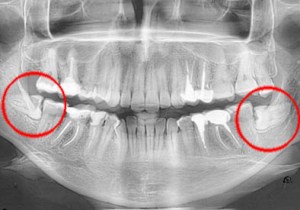 The structure of the jaw modern man makes it increasingly difficult for wisdom teeth to erupt. Sometimes they simply do not have enough space on the jawbone, and they remain in the embryonic stage.
The structure of the jaw modern man makes it increasingly difficult for wisdom teeth to erupt. Sometimes they simply do not have enough space on the jawbone, and they remain in the embryonic stage.
But there is also such a phenomenon as. This is a full-fledged molar, but it is completely or partially hidden in the jaw bone or in the gum.
Such teeth, despite the fact that they never erupted, usually have a completely normal sizes. In addition, they can get sick just like the rest.
The growth of wisdom teeth is very individual. Both the time of eruption of the "eights" and their location on the human jaw differ.
In any case, given the peculiarities of the structure and development of wisdom teeth, you need to treat them with special care. If necessary, contact your dentist immediately.
Most of the changes in our body go unnoticed. Who can now remember how many centimeters he has grown in the 15th year of his life and how much a wisdom tooth grows? Like, important points, but the memory of this is quickly erased, a person begins to perceive himself as "new" as the only true and possible option.
What can cause toothache?
We remember about teeth only when they start to bother us:
- Unbearable pain does not allow you to sleep at night, causing fatigue and impotent anger;
- Every meal becomes a torment;
- You have to constantly chew on only one side;
- From solid food gradually refuse;
- Any thoughts about the dentist are accompanied by no less horror than memories of cold tea after a hot dinner.
No one is immune from dental problems. Of course, constant care and regular visits to the dentist increase the chances of a well-being smile, but even this is not 100% protection of teeth from any damage.
Pain is always indicative of pathological process. As a rule, it is a companion of inflammation:
- Due to improper gum care;
- Due to the destruction of a previously damaged tooth;
- Due to problems with eruption;
- Because of the food left between the teeth.

Do wisdom teeth heal?
Not every wisdom tooth is subject to immediate removal, if there is any problem.
Dentists usually try to save the "eight":
- If the tooth has already erupted;
- When there are chances for a "prosperous future";
- With an unexpressed inflammatory process.
A molar tooth can be sealed in the same way, a pin inserted into it and any other dental manipulation can be performed. If the doctor thinks that it is easier to drill and grind off part of the enamel, that is exactly what he will do. After all surgical removal- a procedure with many possible complications. They try to resort to it in extreme cases but a lot depends on the doctor.
Ask your dentist:
- Is it possible to leave a tooth;
- What amount of treatment is needed;
- How to take care of the oral cavity after manipulation;
- In how many sessions can you achieve improvement.
Do not trust the phrases: "Yes, why do you need this tooth, it still does not participate in chewing, let's remove it." Complications will go to you, in which case, and not to the dentist. So think first of all of your well-being.
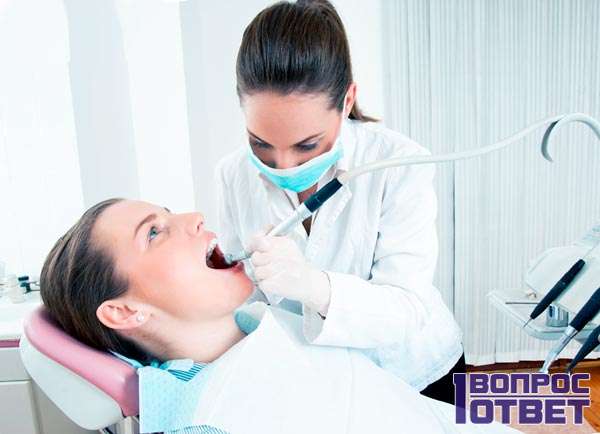
Climbing a wisdom tooth - what to do?
The period of wisdom teeth eruption itself can stretch from several weeks to a couple of months. Patients do not have enough patience for more and they themselves go to the doctor when pain and constant discomfort outweigh the fear of the dental office.
If you find that the "eight" is growing somehow wrong:
- Make an appointment with a dentist;
- Rinse your mouth with anti-inflammatory agents;
- Do not lean on narcotic painkillers;
- Use non-steroidal anti-inflammatory drugs;
- Do not delay your visit to the doctor.
At home, it will not work to “align” the tooth, since it has already begun to grow in a wrong way. Even with pliers in hand, you won't be able to do anything. Painkillers and anti-inflammatory drugs will only help get rid of unpleasant symptoms in the form of pain, swelling and redness.
The dentist must:
- Examine the oral cavity;
- Send for X-ray;
- Based on the conclusion, decide on further tactics;
- Notify you of possible options;
- Remove or repair a tooth.
Theoretically, all this can fit in one session, without stretching for several days. The main thing is to gather courage and force yourself. After all, even if it turns into an hour discomfort but then the pain will go away.
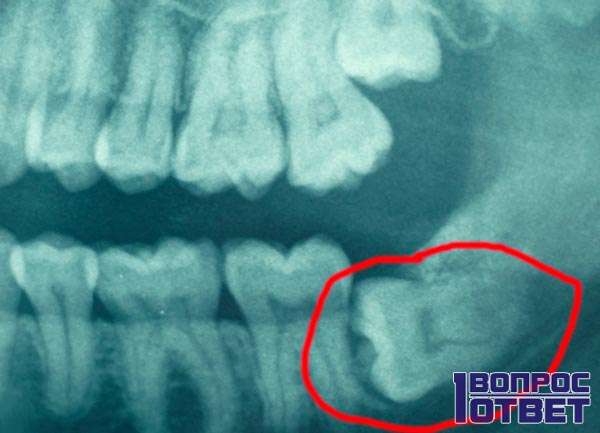
Are wisdom teeth necessary?
In fact, a person has many rudimentary "processes" and wisdom teeth are one of them:
- They erupt after puberty, before that a person chews food without any problems;
- Do not participate in the act of grinding food;
- Remain "hello" from our ancestors with a large facial region of the skull;
- Absolutely not needed with modern jaw sizes;
- Missing in some people.
Even if someone has moved to the next stage of evolution, most still acquire 4 additional teeth, closer to 20 years. The gift is not pleasant, considering possible complications when it appears and after removal, but there is nowhere to get away from it.
Anatomists in the human skull distinguish two sections - facial and cerebral. To make it clear - the cranium, in which the brain fits. And the face - mouth, nose, eyes, brow ridges. In a modern person, the brain section prevails over the facial one - in terms of size.
Our ancestors did the opposite:
- More pronounced forehead;
- Huge brow ridges;
- Protruding jaws;
- Large circle, on which 32 teeth fit.
Evolution, which went on as usual, changed the proportions of the head. But the number of teeth remained unchanged. And although now each jaw has become a couple of centimeters shorter - just 2 teeth above and below, the number "32" continues to haunt humanity to this day. With rare exceptions.
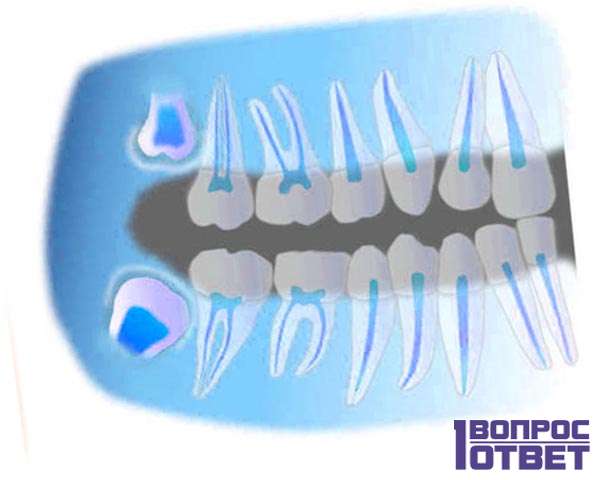
Problems with "eights"
Wisdom teeth - 4 rudimentary "processes" inherited from distant ancestors:
- They do not take part in the mechanical grinding of food;
- Erupt within a couple of weeks, if without complications;
- Due to the lack of space, their appearance may be accompanied by pain and inflammation;
- The first "candidates for removal" at many dentists.
Despite their uselessness, not all dentists prefer to remove the "eight". And all because of the risk of complications, and there is already a complete set. Starting with mild swelling and ending with severe intoxication.
If your molars have begun to cut:
- Make sure with a mirror that they grow in that direction;
- When painful sensations - rinse the mouth with anti-inflammatory drugs;
- If you can't stand it, use painkillers, the same NSAIDs can help;
- As soon as there are suspicions that the process will be delayed, make an appointment with the doctor.
Don't put off until tomorrow what can be done today. Well, or this week.
The pain makes you wonder how much the wisdom tooth should grow and how much longer can it be tolerated? Unfortunately, if there is not enough space, the process can drag on for an unlimited period of time.
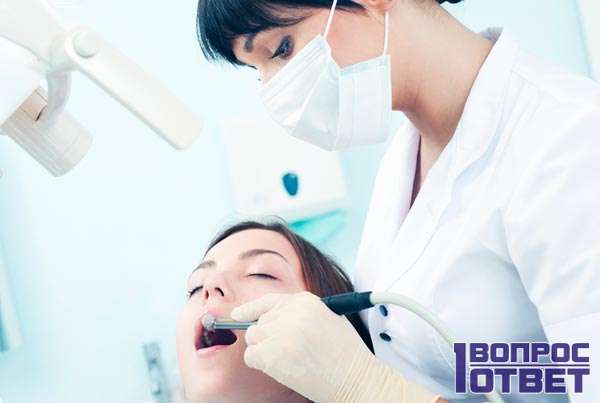
Video about teeth growth
In this program, guest dentist Anatoly Lopatin will tell you at what age wisdom teeth grow, what they are for and how to properly care for them:
Quite often during dental appointment patients ask the doctor a question - when do these molars grow? This is due to the fact that in the process of forming the dentition even in infancy, the eights do not participate, and after the change of milk teeth to permanent ones for quite a long time, the third chewing molars do not erupt. Knowing that normally a person should have 32 teeth, patients ask themselves the question - at what age do eights appear?
In the course of evolution, the human jaw, and with it the dentition, has undergone significant changes, the premise of which was a change in the characteristics of foods eaten. After thermally processed, soft foods began to predominate in the diet, the size of the human jaw gradually decreased by more than 10 mm, and the number of teeth was reduced to 32.
To date, most dentists tend to consider the mouth of a modern person as vestigial organs. There are several reasons for this, first of all, a decrease in the functional load on the third molars. However, when removing adjacent to the eight chewing teeth for one reason or another, the erupted wisdom tooth is displaced in their place and takes on the chewing load to the fullest. In addition, it can serve as a support for various orthopedic structures.
When is a wisdom tooth cut? For each person, this process is individual and depends not only on the characteristics of his body, but also, to a large extent, on the genetic predisposition. All 4 eights do not always grow. There are people whose third molars erupt partially (only 1 or 2), but there is a category of patients who do not have wisdom teeth throughout their lives.
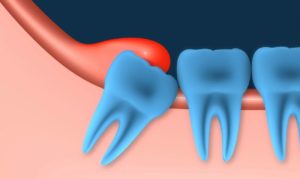
At what age should we expect the appearance of third molars? The formation of the rudiments of eights in the jaw is observed in parallel with the beginning of the change of milk teeth to permanent ones. This happens when the child is 6 years old. The process of formation of the crown part of the third molars is quite long, takes several years and ends at the age of 14-17 years. The wisdom tooth begins to grow only after its crown is fully formed. But even after the figure eight cuts through the gum mucosa, its roots continue to grow for another 3-4 years.
When can the last molars begin to erupt? For each person, the age when eights appear is individual and is determined by the characteristics of his body. For the first time they begin to appear after 17 years. Dentists note a certain pattern - the third molars grow in pairs, that is, this process is observed simultaneously on the right and left of one jaw row.
A characteristic feature of the process when a wisdom tooth is cut is its significant duration, due to the periodic cessation of the growth process. The change in periods of activity and rest causes the erupting tooth to grow for more than one year, and it can finally come out after decades.
The answer to the question is also ambiguous - how many years wisdom teeth grow. As a rule, their eruption ends by the age of 30, however, clinical cases are described in dental practice when the third molars began to erupt in a patient after 40 years.
teething signs
When a wisdom tooth climbs, a person has characteristics this process. The specific symptomatology is due to the fact that the third molars do not have predecessors in the form of milk teeth, therefore, when a wisdom tooth grows, it has to make its own way into the bone tissue.
If wisdom teeth are cut, the patient notes the appearance of the following signs:
- the presence of pain on the opposite side of the face, where the third molar begins to grow;
- the formation of mucosal edema in the area of the erupting tooth;
- slight swelling of the cheeks from the side of the growing figure eight;
- enlargement of regional lymph nodes.
While the wisdom teeth are growing, a kind of pocket is formed above them from the mucous membranes of the gums. With insufficient oral hygiene, food debris and bacterial plaque can accumulate in it, which can cause the development of an inflammatory process. In this case, the patient may additionally have such a pathological sign as an increase in the overall body temperature to 37-380.
How strongly the characteristic symptoms of the growth process of the third molar will be expressed is largely determined by such factors as the presence of free space in the jaw row for the unhindered growth of the figure eight, as well as the position that its rudiment initially occupied in the bone.
What can hinder the eruption process
Significantly affect clinical picture and the duration of the process, when a person may have certain anomalies in the development of their rudiments in the bone:
- change in terms of development (later onset of the formation of the germ);
- incorrect anatomical location in the bone (tilted, horizontal);
- excessively dense shells of the dental sac;
- abnormal shape of the rudiment or its size.
Such pathological disorders cause not only the difficulty in the process of teething the wisdom tooth. Additionally, a person develops excessive crowding of teeth, which over time leads to the destruction of units located close to the growing tooth, various malocclusion. In some cases, for example, when the germ is located horizontally in the jaw bone, the third molar cannot grow at all and the person is forced to seek specialized help from a dental surgeon to remove it.
An additional difficulty in the process of growth of the figure eight is the formation of a gingival pocket between its erupted part and the gingival mucosa. The accumulation of food debris in this gap leads to the formation of an inflammatory reaction, as a result of which the patient experiences increased pain, violation of chewing functions, the appearance bad smell from the mouth, discharge of pus from the pathological site. Correction of such a violation is also carried out by a dentist-surgeon, who, after preliminary anesthesia, excises an excess section of the gum mucosa.
In dental practice, quite often doctors are faced with such clinical situations when a fully formed wisdom tooth never erupts. Such units should be removed as soon as possible.
This is due to two factors. Firstly, in the case of incomplete formation of the roots of the tooth, it is much easier to extract it from the bone. Secondly, over time, an impacted tooth can not only be affected by a carious process, but also contributes to the destruction of the roots of neighboring teeth, the occurrence of a focus of inflammation.
What complications may arise
As a rule, the process of eruption of the last molars in humans is characterized only by the presence of pain and some difficulties in chewing food. Such symptoms disappear without a trace immediately after the eights finally cut through bone tissue. However, in some cases, the patient may develop various complications in the process of their growth, some of which pose a real threat not only to health, but also to human life:
- Untimely appeal for specialized help to a dentist-surgeon in the formation of a gum pocket and a prolonged inflammatory process in this area can cause the development of a subperiosteal abscess.
- Formation in the region of the roots of the third molar of a cancerous cyst filled with purulent contents (flux). In some patients, this process proceeds without pathological symptoms and is discovered by chance during an x-ray examination of neighboring units. In other clinical cases, a fistulous passage is formed, and the purulent sac is located on the surface of the gums.
- Phlegmon - the formation of a purulent focus in the soft tissues around the third molar. When it is formed, urgent specific treatment is required, since the infection from this area can easily spread through the cellular space and cause the development of sepsis (blood poisoning) and other terrible complications. The increased threat of generalization of the infectious process is due to the anatomical features of the location of the wisdom teeth.
- Violation of the digestive processes due to the presence of pain - in this case, the patient cannot chew food well enough.
It is quite easy to avoid such complications. When the first signs of eruption of wisdom teeth appear, it is necessary to seek the advice of a dentist and conduct an x-ray examination of the growing unit. This will help determine what position the tooth bud occupies and in which direction it grows (up or to the side).
In the presence of serious anomalies in the formation of the last molars, an X-ray examination allows you to timely carry out the necessary medical measures and prevent future complications.
Regular preventive examinations at the dentist, twice a year, provide constant medical control over the process of eruption and growth of wisdom teeth.
The extreme bone organs in dentistry are called the "eight". Their laying occurs at the age of three years, at this time it is determined what their number will be. Formation takes a long time, some people get out all 4 teeth, and many may have only 1-2. How long does a "wise" tooth grow and how does it happen?
How wisdom teeth erupt
Located on both sides at the end of the lower and upper jaw, serve to aid in the process of grinding food. Like all paired bony organs, they fit symmetrically to each other. Eights were named because they are the eighth in a row relative to the middle incisor. No matter how many molars grow, they are rarely located on the bone in the correct position. More often, molars develop or erupt with some kind of problem or complication. This is expressed in the wrong direction of growth or location, which sometimes does not do without the help of a dentist.
At what age do the eighth teeth grow? For each, they begin to climb in different ways, but at any age, the body, especially in adults, reacts painfully to the process. Often, the extreme molars "push" neighboring bone organs, provoke their abnormal growth or inflammatory process. Reasons why it is better to remove the last molar:
- fever the body lasts more than 2-3 days;
- the inflammatory process of the entire dentition began;
- disturb severe pain, swelling of the gums appeared, which made it difficult to eat.
The extreme molars look the same as many other multi-rooted bone organs. However, according to the structure of the eight, they still have certain differences. This applies to that part of them that is hidden in the gum. Eights have four or five roots, but there are only one or two, as a result of the fusion of several roots into one. The root canals of figure eights are curved, making them difficult to pluck or treat.
At what age do wisdom teeth grow
It is impossible to give an unambiguous and clear answer to this question. The figure eight grows from a couple of months to tens of years, causing pain and causing other inconveniences. Every person has the rudiments of extreme molars, but this does not mean that they will necessarily grow even in old age - it is difficult for them to erupt due to the peculiar structure of the jaw, so they can remain in the embryonic stage for the entire life period.
When does the wisdom tooth begin to grow?
For most of the human population, the figure eight has been growing since the age of 17, but the process can drag on and begin at 22. Some people may notice that their extreme bone organs are cut much later - at the age of 30-40 years. Each person should have 4 eights, but they may not erupt at all. Often only two of them grow, while even an x-ray shows that there are no more primordia. The number of extreme bone organs depends on such reasons:
- heredity;
- the number of bone rudiments;
- anatomical features jaw, its shape.

Until what age do wisdom teeth grow?
The answer is interesting - there were cases when the extreme molars could erupt from several tens of years, and during this time the period of growth and rest alternated. Their coronal part is just beginning to form, when the rest of the child's bone organs have already erupted. Even after the figure eight has cut through, its roots are still being formed, which in time can take another three to four years.
In dentistry, wisdom teeth are called figure eights, as they are symmetrically located at the top and mandible on both sides, and are considered eighths from the middle incisor. For many patients, the question often arises of how old wisdom teeth grow, as they can provoke pain, discomfort during eruption.
Peculiarities
The process of eruption of teeth in oral cavity in humans occurs in the childhood period of development, but wisdom teeth are an exception. Late appearance determines their very name. The question of when and how many years wisdom teeth grow is not fully understood at the present time, and dentists cannot give an exact explanation and reason.
Some people may erupt four units at the same time, while others will not have one. Each person has a completely different time of appearance, which is determined by their location features. The reason is that, with rare exceptions, they are positioned correctly during active growth.
Basically, wisdom teeth, or as dentists also call them third molars, during development have anomalies in location or direction of growth, causing discomfort.
Often their growth occurs at the wrong angle in relation to other dental units, the jaw, and they can also abut against neighboring roots or on the cheeks. Long before they appear, there is pain in the gums, swelling is observed in the places of eruption. Why this happens may also depend on factors such as the anatomical structure.
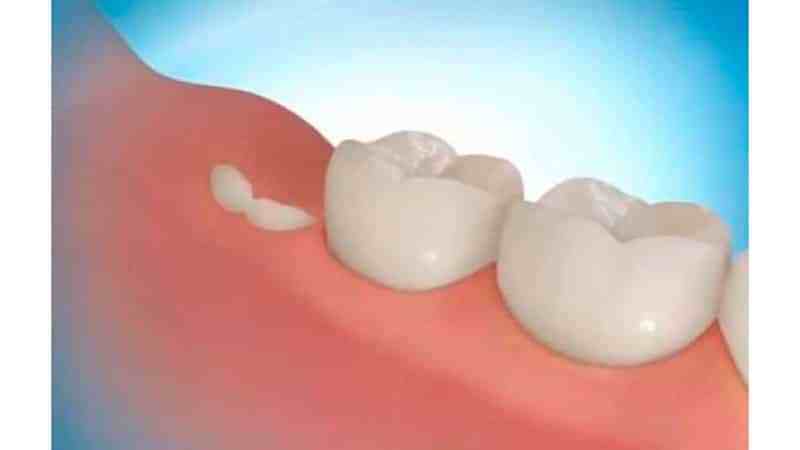
Each person has a different timing for the appearance of a wisdom tooth.
Wisdom teeth do not differ from others in appearance, but differ in structure. It should be noted that the root permanent teeth finally formed to adolescence with one root. And wisdom teeth, which can erupt only from this period and usually grow in pairs, have from one to five roots fused together into one. Root canals often show curves that prevent treatment and require surgical intervention.
Terms of eruption and growth of eights
In addition to such a question as how old teeth grow, people are concerned about the time of their eruption. In addition to the structure of the jaw, on which growth depends, the place, which may be lacking, also matters. If the location of the figure eight is insufficient, adjacent teeth are shifted, which affects the formation of the correct bite.
With severe crowding, the presence of aching pain, dentists often recommend removing it.
The duration of the growth of wisdom teeth, unlike the rest, scientists explain the history of human development. In ancient times, human teeth erupted painlessly and in the same time, since the size of the jaw was larger, and therefore they erupt freely in it without pain. But over time, the jaw in its structure has decreased in size, due to a change in the nature of food. A person began to consume processed foods, making dishes soft.
Eights in those days did not differ in external structure from the rest, but now doctors note the absence of a need for them. They do not bear special loads and are not functional. Long eruption is due to poor blood supply at the edges of the gums.
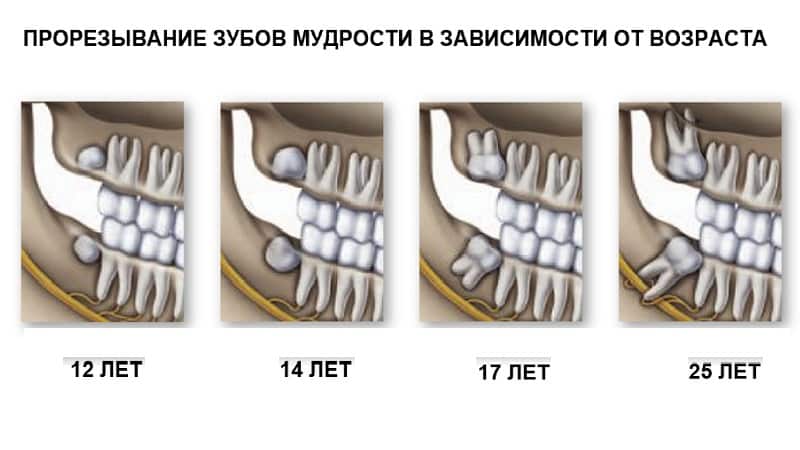
Wisdom teeth begin to form after the change of milk to permanent teeth
From time to time, during eruption, an exacerbation occurs with inflammatory processes, pain, which indicates active growth. And to speed up the eruption, dentists recommend massage.
Today it can be noted that many people do not always have a complete set of permanent teeth in the amount of 32 pieces in the oral cavity. Wisdom teeth sometimes remain in the jaw in an embryonic state, which indicates individual characteristics. But in any case, doctors recommend treating the symptoms of their appearance with special attention, in case of problems, urgently seek help from specialists.
The beginning of the formation of wisdom teeth occurs after the change of milk teeth to permanent teeth, which approximately refers to the age of 13-15 years. The eruption of these units begins at the age of 18, and the formation of the root occurs after the age of 24. And wondering how long teeth grow, doctors indicate only an approximate period of time up to 30 years, and even in exceptional cases older age. Also possible exceptional cases when a person has no wisdom teeth at all, which is explained by an incorrect location in the jawbone.
There are situations when in a person they erupt in adulthood, in rare cases even in people who are 50 years of age or older.
Experts say that the number of teeth in a person is initially laid down by the genetic level of its development.
Pathologies
After the complete formation of the seventh dental units (second molars), the third molars begin their development, eruption. They grow from the germ, formed for a long time after the formation of the crown. The germ begins to develop at the age of six, but it has such pathologies as:
- abnormal location;
- there are thick shells in the dental sac;
- the development period is broken;
- many primordia in one area;
- wrong shape, wrong size.
With the development of pathology in the germ, the wisdom tooth can erupt and grow for a long time, with the presence acute pain, and not full exit over the gum crown. At the same time, the bite may be disturbed, as well as the destruction of other teeth, their crowding.
Complications
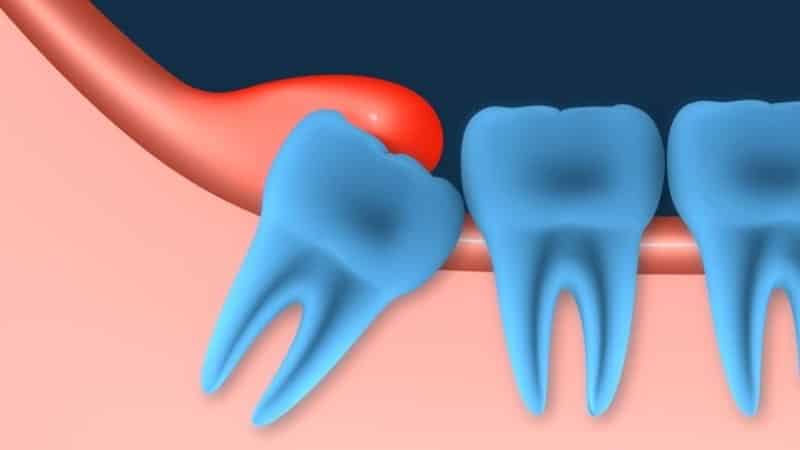
Wisdom tooth eruption
To the most common complications during growth, people experience inflammation in the gums in the tissues located near the tooth. During its growth, a tuberculous formation appears on the surface of the gum, covered with a mucous membrane (hood). This place is prone to injury, mechanical damage from eating solid food, which subsequently affects the active development, reproduction harmful microorganisms, bacteria and suppuration.
Such formations are a sign of pericoronitis - a disease that begins with minor pain in the area of \u200b\u200beruption of the figure eight. With the further development of inflammation, the pain begins to intensify, radiating to the temples, ears, when swallowing, opening the mouth. Possible pain in the facial muscles, inflammation trigeminal nerve, lymph nodes, sometimes the temperature even rises, the head hurts. Puffiness, redness in the area of the formed hood is accompanied by the release of pus.
In this case, it is necessary to urgently consult a doctor, take a picture in the area, carry out treatment or remove it in a timely manner in order to prevent complications.
Dentists in the treatment of pathologies open the mucous membrane, wash the cavity and prescribe anti-inflammatory drugs. In most situations, with repeated inflammation, it is necessary to remove a unit that has not yet appeared. To one more common problem in the process of eruption is the appearance of caries.
The main cause of the disease is associated with poor hygiene in a hard-to-reach place for the development of the figure eight, and from a snug fit, the disease quickly spreads to neighboring teeth.
In the absence of external signs of inflammation, it is necessary to take a picture in order to know in advance about the correct growth of the tooth and the need for its removal.
The need for removal
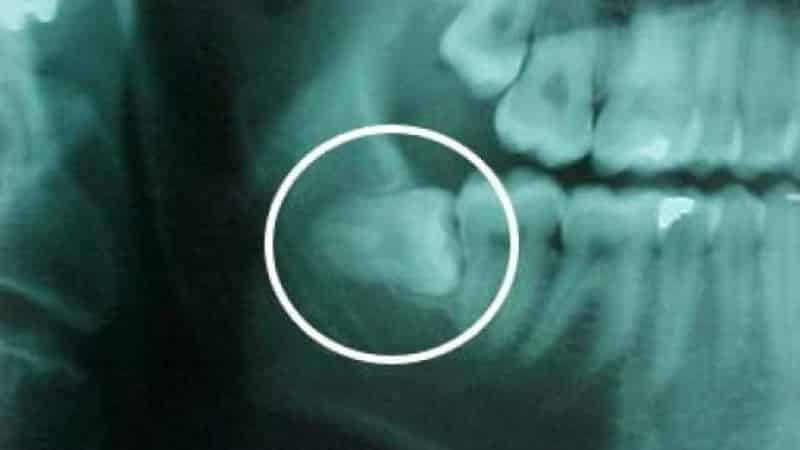
Wisdom tooth grows sideways
Along with the question of how old the wisdom tooth grows, many people are concerned about the need to remove the wisdom tooth if problems arise, pain with its eruption. For surgical intervention There are certain indications that dentists warn about:
- impacted wisdom tooth, which means wrong location in the jaw. He will not be able to erupt due to partial or complete emphasis on adjacent teeth;
- impossibility of filling due to hard-to-reach location;
- the process of long eruption can provoke the development of caries;
- partial eruption, which results in an inflammatory process with pain;
- pain in the trigeminal nerve;
- appearance cystic formation in the lower jaw;
- pain in the head, during swallowing, other painful conditions;
- permanent mucosal injury.
It should be noted about the consequences of removal, which is primarily associated with trauma to the jaw with slow wound healing and complications. After removal, there may be It's a dull pain, which indicates inflammation of the hole. The normal healing process occurs by covering the hole blood clot protecting it from microbial ingress.
After removal, rinse should not be carried out, since washing out the clot leads to infection. As a result, it may be necessary to repeat the surgical intervention, especially in cases of numbness of the tongue, lips, chin, which does not go away for a long time.
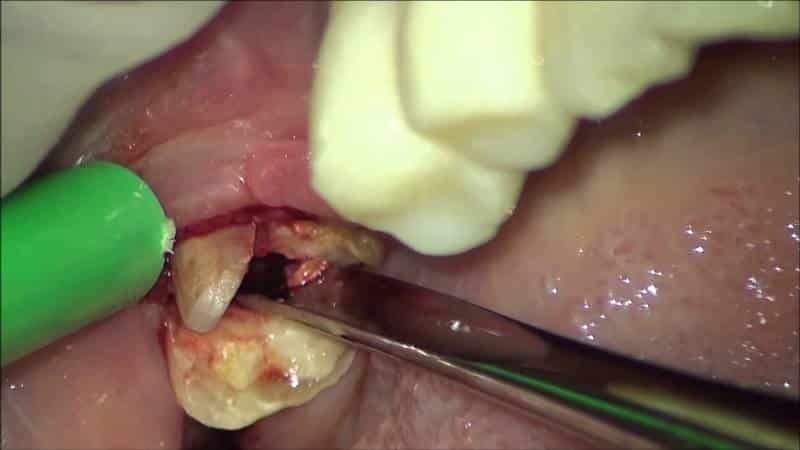
Wisdom tooth extraction
In conclusion, we note that rapid eruption reduces the development of inflammation. And a long growth process is a fertile ground for the accumulation of bacteria and the development of various dental diseases. The question of the time and age at which the wisdom tooth grows depends on the individual characteristics of the anatomical structure of the jaw, genetic heredity, as well as the sufficiency of space in the dentition.